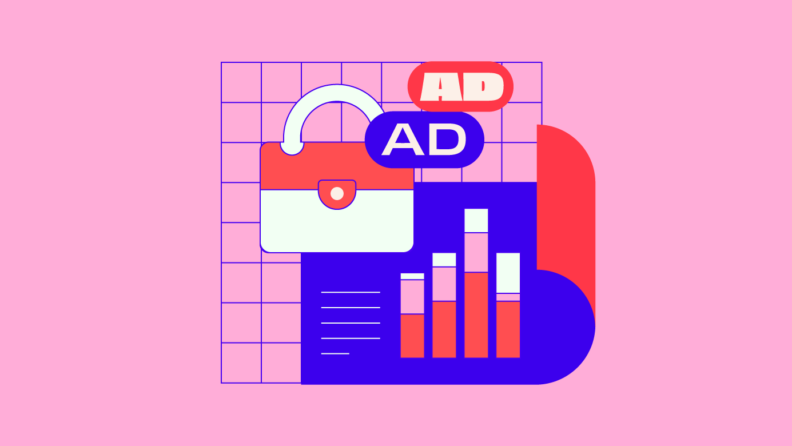Harness Multiple Data Types and Sources: Leverage firmographic, technographic, intent, and demographic data from internal, external, and emerging sources to build a comprehensive view of your target audience.
Embrace Emerging Trends in AI and Privacy: Prepare for the future by integrating AI tools like predictive analytics into your strategies and adopting privacy-first practices to earn buyer trust and maintain compliance.
Evaluate Outsourcing vs. In-House Collection: Decide whether outsourcing, in-house collection, or a hybrid approach is right for your business by balancing access to verified data with customization and control.
B2B marketing data can elevate your B2B marketing strategy, improve audience targeting, ABM personalization, lead generation and more. More importantly, it empowers your team to make informed decisions that drive measurable results.
But where does this data come from, and how can your business collect it effectively? In this guide, we’ll explore the different types of B2B marketing data, where to source it, and how to leverage it to maximize your marketing impact.
What Is B2B Marketing Data?
B2B marketing data refers to any information businesses can use to support their marketing efforts. This could be target account contact information, funding details, revenue or decision-making hierarchies.
Its primary purpose is to improve your ability to identify, target and engage potential customers. The result? Improved lead generation, conversion rates, and customer retention.
Benefits of B2B marketing data
- Personalization: Data supports the creation of personalized campaigns by helping you understand the behaviours and goals of your target audience.
- Optimized Campaigns: Data allows you to refine your strategies by analyzing past performance data and improve ROI.
- Data-Driven Decisions: Reliable data enables CMOs to back their decisions with measurable insights rather than assumptions.
B2B marketing data is the foundation of successful campaigns, enabling you to go beyond generic messaging and create personalized, impactful marketing initiatives.
As Kelvin Gee, Principal Analyst for Forrester and former Senior Director at Oracle, highlights in his interview with Top Rank Marketing, “We believe that data is the future of B2B marketing. If the goal is to deliver a better customer experience, you’ve got to break down those data silos.”
Types Of B2B Marketing Data
There are five key types of B2B marketing data:
Contact Information
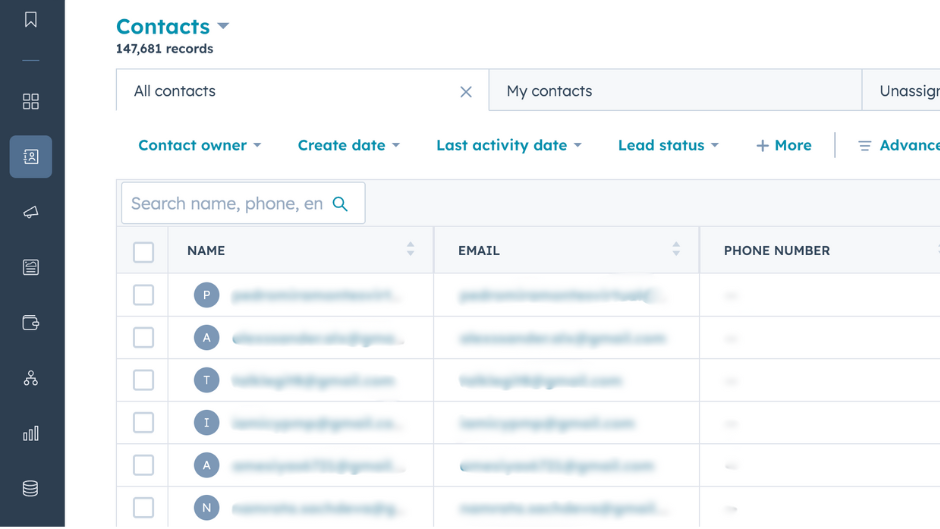
Ensures that your outreach efforts connect with the right people, helping you build relationships with decision-makers faster.
- Name
- Emails
- Phone number
Demographic Data
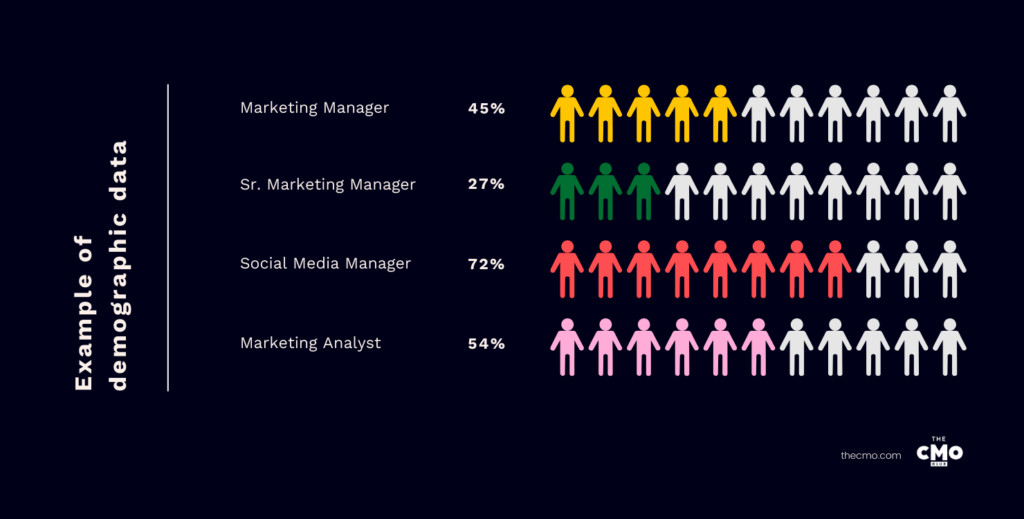
Provides insights into the roles and responsibilities of your audience, enabling you to craft personalized messaging that addresses their specific pain points and objectives.
- Job Title
- Department
- Seniority
Technographic Data
Technographic data sheds light on a company’s tech stack, helping your marketing team position your product as a complement, or superior alternative, to their existing tools. This is typically collected through digital footprints, scraping, and third-party providers.
- Tech infrastructure
- Hardware
- CRM, CMS, ERP, and other software the company is using
- Software adoption rates (technical maturity)
Firmographic Data
Helps you identify high-value accounts and prioritize your efforts based on company size, revenue potential and geographic location.
- Company’s size
- Industry classification
- Revenue
- Location, and industry classification
Intent Data
Intent data zeroes-in on qualified leads displaying high purchase intent, enabling you to engage them at the right time with relevant offers. It tracks the behaviors and signals that indicate a company’s interest in a product or service.
How Is B2B Marketing Data Collected?
Understanding where B2B marketing data comes from is essential to building a data-driven strategy. Businesses today have access to a growing variety of data sources, categorized into internal, external, and emerging.
1. Internal (First-Party) Sources
Internal sources include data collected from your owned channels. This type of data is highly reliable and relevant, as it’s gathered straight from your audience.
Website Analytics
Tracks user behavior, traffic sources, and conversion paths.
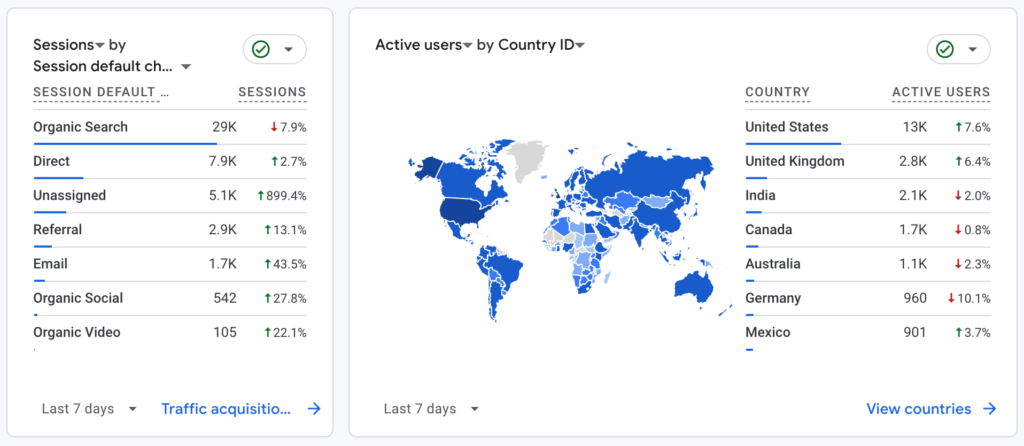
Social Media Accounts
Provides insights into audience engagement, preferences, and demographics.
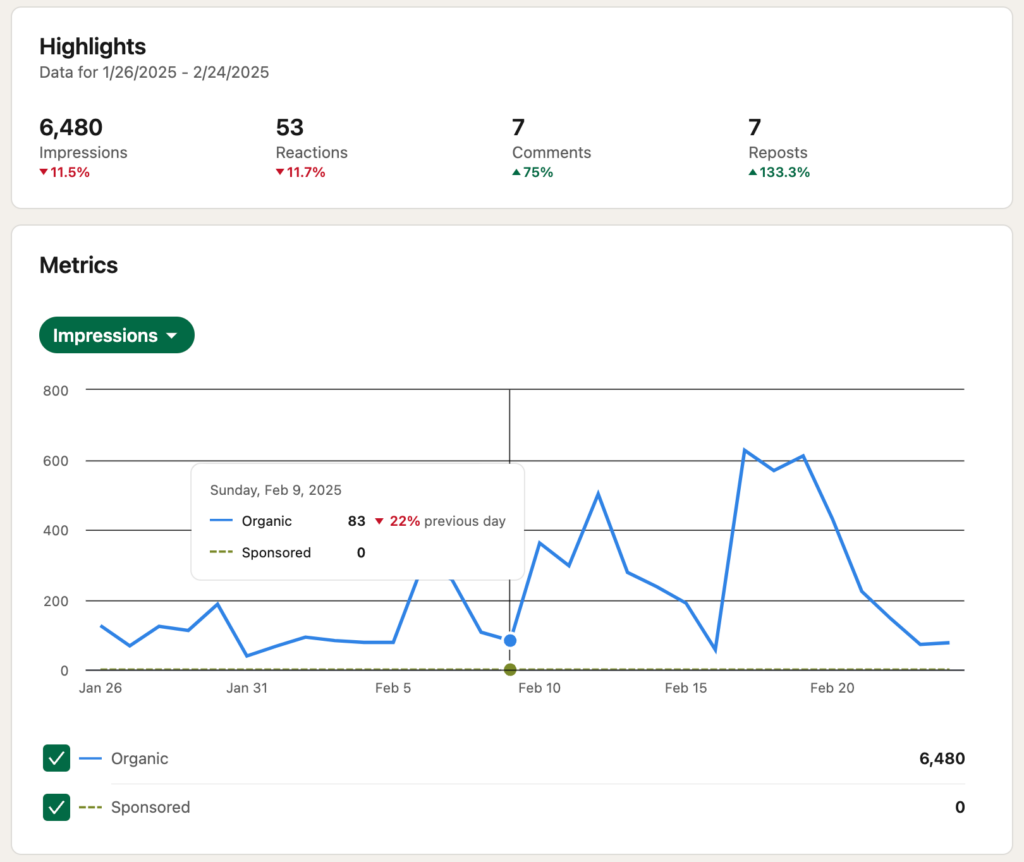
Lead Form Submissions
Captures essential details such as job titles, company names, and contact information.
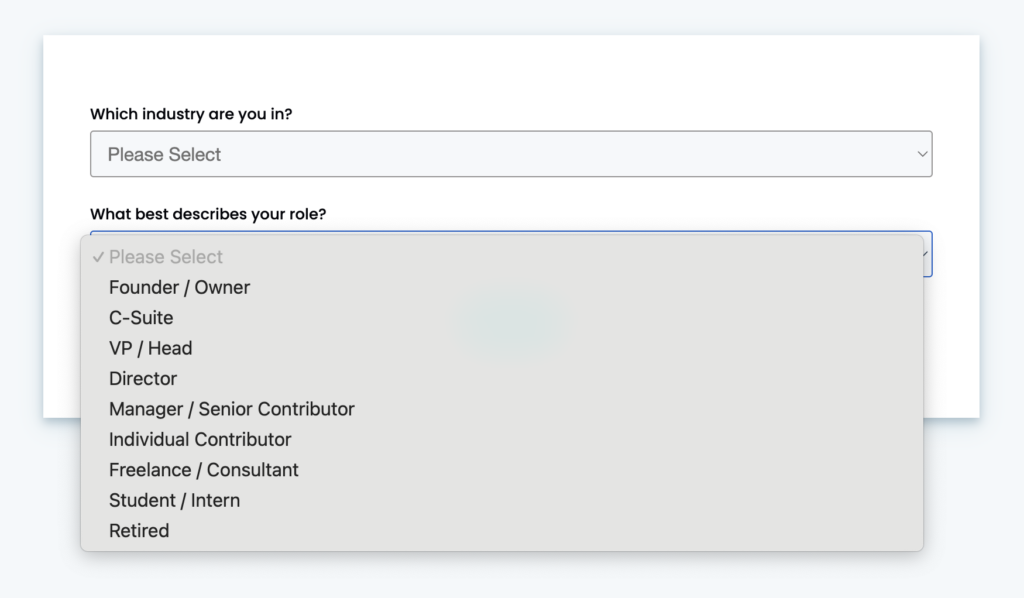
2. External (Third-Party) Sources
External sources include data collected and supplied by third-party organizations. These providers aggregate information at scale, offering businesses a broader view of the market.
Examples include:
- B2B Data Providers: Platforms like Cognism and 6sense collect and supply firmographic, technographic, and intent data at scale.
- Public Databases: Sources like LinkedIn or government databases provide industry-wide insights.
- Data Marketplaces: Allow you to purchase datasets tailored to your target audience or industry.
3. Emerging Sources
Emerging sources refers to newer technologies and platforms providing innovative options for data collection and analysis.
Examples include:
- Customer Data Platforms (CDPs): Centralize data from multiple touchpoints, creating unified customer profiles.
- Review Websites: Platforms like G2 and Trustpilot reveal valuable customer feedback and buying signals.
- The Internet of Things (IoT): Connected devices generate behavioral data, offering insights into product usage or customer preferences.
How To Use B2B Marketing Data
When used correctly, B2B marketing data can transform the way you reach both existing and new customers. Data-backed strategies can help you engage with prospects, personalize messaging, and win new business. Let’s explore a few key use cases for marketing data.
1. Lead Generation
Lead generation is a top priority for most marketers, with 29% ranking it as the most important metric for evaluating the impact of content strategies (Hubspot, 2023). Marketing data improves your ability to identify and segment ideal prospects, increasing qualified leads and maximizing ROI.
By analyzing firmographics, technographics and intent data, you can pinpoint companies that align with your offerings. For example, if your data shows a surge in searches for “CRM solutions” from mid-sized tech companies, you can target those prospects with tailored outreach or ads.
2. Account-Based Marketing (ABM)
Successful account-based marketing strategies require data, and lots of it. B2B marketing data drives the research and creation of target account lists and ideal customer profiles (ICP), two crucial components of an ABM approach.
In fact, companies with a data-backed ICP achieve 68% higher account win-rates (TOPO, 2019). With insights like job titles, decision-maker contact information, and company revenue, you can create hyper-personalized campaigns that address the needs of specific accounts, maximizing the ROI of your ABM strategy.
3. Market Segmentation and Personalization
Personalization and audience segmentation are crucial for business-to-business relationships, with 66% of B2B buyers expecting all of their interactions with a brand to be personalized (Adobe, 2023). High-quality customer data is necessary to deliver these custom experiences, helping your teams segment audiences based on characteristics like company size, industry, and buying intent.
4. Outbound Sales
By segmenting leads, you can send personalized email campaigns that address industry-specific pain points. This boosts engagement and fosters long-lasting relationships with key accounts and decision-makers.
Data-driven sales outreach is more precise and effective, improving win rates. In fact, 82% of sales teams report that leads identified using marketing data, such as intent data, convert faster than regular leads (Mixology Digital, 2024).
For example, a sales rep can use technographic data to identify a prospect who’s actively searching for analytics software. They can then tailor their pitch around integration with the company’s existing tech stack, and address specific use cases that are relevant to that company.
5. Competitive Analysis
Keeping tabs on competitors is one of the smartest ways to refine your strategy and stay ahead in your industry. B2B marketing data allows you to analyze competitor behaviors, uncover their target markets, and identify gaps where your product or service can shine.
For instance, through data analysis you may notice that your competitor is targeting large enterprises in financial services, but ignoring small-to-mid-sized firms. You can then develop a strategy to step in with customized offerings that appeal to this underserved market.
6. Ideal Customer Profile (ICP) Creation
As we mentioned above, your ideal customer profiles (ICPs) are crucial for developing a successful ABM approach. Data helps with the creation of ICPs by highlighting key customer pain points, characteristics and behaviors, ensuring your ICP is centered on prospects with the highest sales potential.
Say you’re looking to target mid-sized SaaS companies with $10M–$50M in revenue. A combination of firmographic data and demographic data can highlight companies within this revenue range, and support identification of key contacts that are responsible for purchasing decisions.
7. Lead Scoring and Nurturing
Not all leads are created equal, and without effective lead scoring and nurturing your best opportunities can slip through the cracks. However, over a third of B2B marketers say they struggle to deliver marketing-qualified leads (Marketing Week, 2024).
This is where marketing data, like intent data, lends a helping hand. With intent data, you can assign scores to leads based on their conversion potential, and nurture them through personalized outreach.
This also improves alignment between marketing and sales, by ensuring all marketing qualified leads (MQLs) are verified through accurate data. A data-driven approach improves lead scoring and nurturing, helping you target and prioritize the accounts that matter most.
Best Practices For Managing B2B Data
B2B data is a valuable asset that requires careful organization and management to remain effective. Poorly maintained data can lead to inaccurate targeting, wasted resources, and even compliance risks.
1. Data Quality and Maintenance
Data-backed marketing strategies are only effective if the data supporting them is accurate. However, poor data quality costs businesses an average of $15 million annually, proving that data maintenance remains a challenge for marketers (Gartner, 2018).
Regular cleansing, validation, and enrichment ensure that your data is accurate, up-to-date, and actionable. For example, removing duplicate records, correcting outdated contact information, and filling in missing fields can improve the efficiency of your campaigns and reduce wasted effort.
2. Data Compliance
Data theft and privacy remains a chief concern for modern business, with a 76% spike in data theft incidents reported globally (Crowdstrike, 2024). Your data must be compliant with legal guidelines, such as the GDPR (General Data Protection Regulation) and CCPA (California Consumer Privacy Act), to protect your business and customers.
Non-compliance can result in hefty penalties and significant damage to your brand reputation. To stay compliant you need to prioritize transparency, ensure proper consent for data collection, and secure your databases against breaches.
For example, maintaining clear privacy policies, offering opt-in mechanisms on lead forms, and encrypting sensitive data can help you meet legal requirements while safeguarding your audience’s information.
3. Database Hygiene
Much like your home, databases also require regular upkeep to remain accurate, accessible and actionable over time. Without proper database hygiene practices, outdated or duplicate records can clutter your systems, leading to inefficient campaigns and inaccuracies.
It’s best to implement automated data cleansing to regularly audit your records, and train your team to input data correctly. For example, scheduling quarterly database reviews can help catch errors before they snowball into bigger problems.
To learn more, check out our review of the best account data management software and discover which solution is right for your business.
B2B Data Providers And Comparison
Key Considerations for B2B Data Providers
When evaluating B2B data providers, consider these factors:
- Accuracy: The quality of the data determines the effectiveness of your campaigns. Look for providers with high verification standards and frequent data updates to ensure accuracy.
- Data Freshness: Outdated data can lead to wasted effort. Providers that update their databases regularly, like Demandbase, ensure you’re working with the most current information.
- Compliance: If your business operates in regions covered by regulations like GDPR or CCPA, compliance should be a top priority. Choose providers like Cognism that prioritize regulatory adherence.
- Integration Options: Seamless integration with your CRM or marketing automation platform can save time and streamline workflows. Check if the provider supports the platforms your team already uses.
The Best B2B Data Providers
More and more, companies are investing in their own first party data systems, but it’s still common to buy (and borrow) data from B2B data providers, such as these:
Trends In B2B Marketing Data For 2025
Emerging trends in AI, data privacy and buyer behaviour are reshaping how companies collect, manage and leverage data. Staying ahead of these trends is essential for marketers and sales teams looking to maintain a competitive edge as we move into 2025.
1. AI and Automation
Artificial intelligence, machine learning and automation are revolutionizing the way businesses use B2B marketing data. For example, predictive analytics is becoming a key tool, helping teams forecast buyer behavior and prioritize leads based on purchase intent.
However, while the potential of AI is clear, it’s important to set realistic expectations. According to Forrester’s 2025 B2B Marketing and Sales Predictions, 49% of U.S. decision-makers expect ROI on AI within one to three years, while 44% anticipate results in three to five years. This means you need to approach AI implementation with a mix of short-term and long-term goals.
As you plan for 2025, identify specific ways AI can enhance your marketing data strategy, such as improving lead scoring, predicting buyer intent, or creating personalized campaigns. Avoid the temptation to scale back on AI too soon, as it’s a long-term game that requires steady investments to unlock its full potential.
2. Privacy and Data Governance
Ethical data management will remain a top priority for businesses, especially as AI-powered data collection and processing become more widespread. Companies will need to implement stricter data governance practices to ensure transparency and accountability in how data is collected, stored, and used.
This shift is not only due regulatory compliance, but also maintaining and earning the trust of your customers. Privacy-first marketing strategies are on the rise, with a greater focus on consent-based data collection and the ethical use of customer information.
For 2025, you’ll need to view data governance as a competitive advantage. Customers are more likely to engage with companies they trust, and proactively addressing privacy concerns is a great way to stand out amongst competitors.
3. Buyer-Centric Strategies
The B2B buying process is growing in complexity, with 86% of purchases stalling and 81% of buyers dissatisfied with their providers (Forrester, 2024). To combat these challenges, buyer-centric strategies such as account-based marketing will be critical for engaging target audiences.
ABM thrives on personalization and leveraging data to understand buyer intent, and as 95% of buyers plan to use generative AI to support purchase decisions in the coming year, this reliance on data will only grow.
Search engines are also evolving through AI Overviews and personalized search results, driving a need for better, buyer-centric content strategies. This will require significant data to create more effective, personalized experiences that enhance visibility on SERPs.
Outsourcing Vs. Collecting B2B Data
Now here’s a common dilemma: Should you outsource data collection or build and manage it in-house? Both approaches have their share of advantages and pitfalls, so the right choice depends on your company’s specific goals.
Let’s take a look at the pros and cons of each:
Outsourced Data Collection:
| Pros | Cons |
|---|---|
| Access to large, enriched datasets immediately. | Can be costly, especially for small businesses. |
| Data is often verified for accuracy and compliance with privacy regulations. | May not be tailored to your exact needs, requiring additional refinement. |
| Saves time and resources for your team. | Reliance on third-party providers for updates and accuracy. |
In-House Data Collection:
| Pros | Cons |
|---|---|
| Complete control over data quality and customization. | Resource-intensive, requires skilled personnel and tools. |
| Ideal for niche markets or unique data requirements. | Time-consuming to build and maintain a database. |
| Helps build internal expertise and proprietary datasets. | Greater responsibility for compliance with privacy regulations like GDPR and CCPA. |
Empower Your Marketing With Smarter Data
B2B marketing data is more than just numbers, but the foundation of smarter, more effective marketing strategies. Data can be leveraged for lead generation, ABM, buyer personalization and more.
By applying the insights delivered from effective data collection and analysis, you can create campaigns that are not only highly targeted, but also aligned with buyer intent. Whether you’re adopting AI tools, refining ABM strategies, or improving data governance, embracing data-driven marketing will position your business for long-term success in 2025 and beyond.
FAQs On B2B Marketing Data
What is the difference between firmographic and technographic data?
Firmographic data provides insights about a company’s attributes, such as size, revenue, industry, and location. Technographic data, on the other hand, focuses on the technology a company uses, like software platforms, tools, or IT infrastructure.
How do I choose a compliant B2B data provider?
Look for providers that prioritize compliance with regulations like GDPR and CCPA. Check whether they offer features like consent-based data collection, regular audits, and tools to help you stay compliant. Providers like Cognism are well-known for their focus on data compliance.
What are the best practices for data validation and maintenance?
Regularly cleanse your database to remove duplicates, validate outdated information, and fill in missing data fields. Use tools like Oracle CX Sales or WinPure to automate this process and ensure your data stays accurate and actionable over time.
What is an example of B2B data?
An example of B2B data is a database of contact information for decision-makers within mid-sized SaaS companies, including job titles, email addresses, company size, and the technologies they use.
Join For More B2B Marketing Insights
Ready to grow? Subscribe to The CMO newsletter to stay on top of trends and get the latest tips, resources, and guides from our community of seasoned marketing leaders straight to your inbox.

